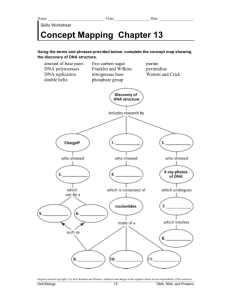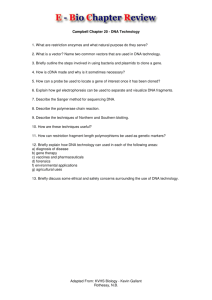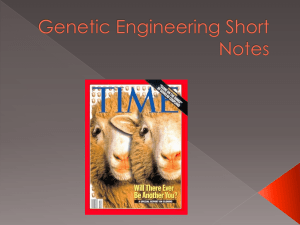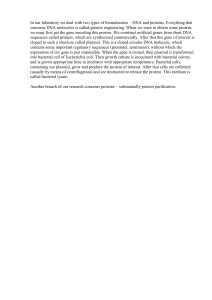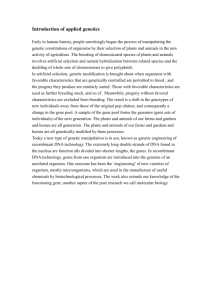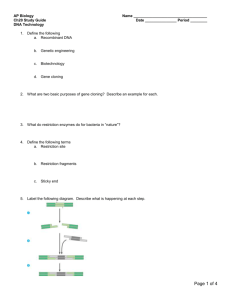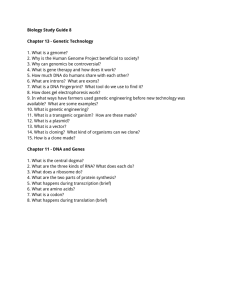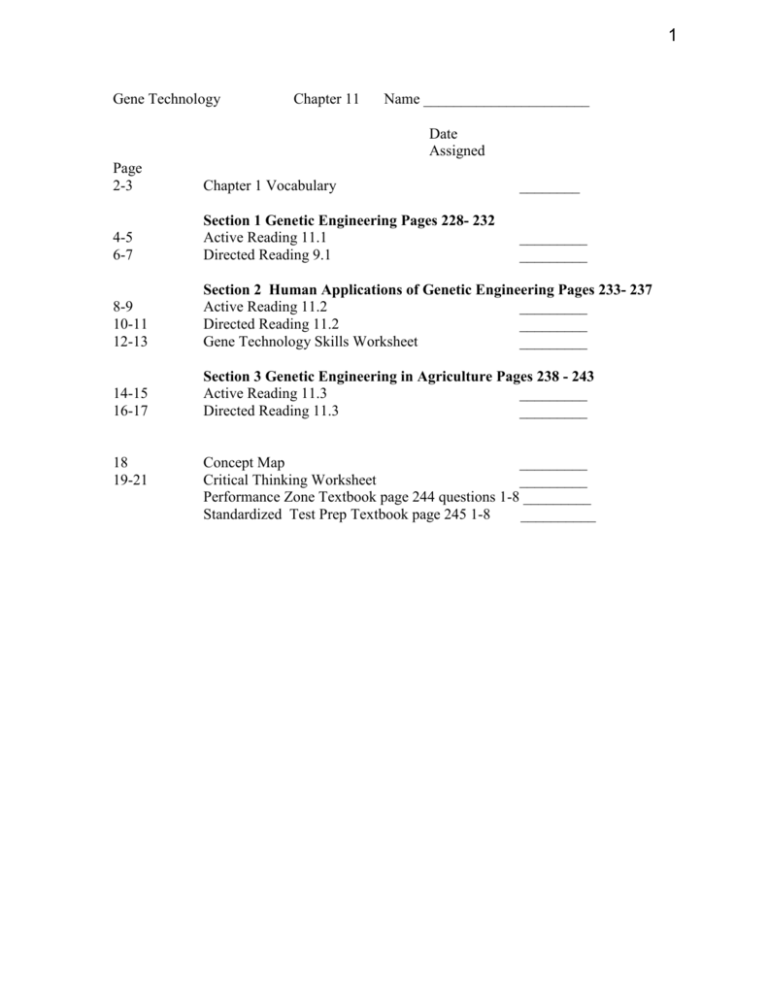
1
Gene Technology
Chapter 11
Name ______________________
Date
Assigned
Page
2-3
Chapter 1 Vocabulary
________
4-5
6-7
Section 1 Genetic Engineering Pages 228- 232
Active Reading 11.1
Directed Reading 9.1
_________
_________
8-9
10-11
12-13
Section 2 Human Applications of Genetic Engineering Pages 233- 237
Active Reading 11.2
_________
Directed Reading 11.2
_________
Gene Technology Skills Worksheet
_________
14-15
16-17
Section 3 Genetic Engineering in Agriculture Pages 238 - 243
Active Reading 11.3
_________
Directed Reading 11.3
_________
18
19-21
Concept Map
_________
Critical Thinking Worksheet
_________
Performance Zone Textbook page 244 questions 1-8 _________
Standardized Test Prep Textbook page 245 1-8
__________
2
N
Name ____________________________ Date _______________
Section 1
Chapter 11 • Gene Technology Key Terms
Section 1
1. genetic engineering (228)
2. recombinant DNA (228)
3. restriction enzyme (229)
4. vector (229)
5. plasmid (229)
6. gene cloning (229)
7. electrophoresis (231)
8. probe (231)
Section 2
3
Section 2
9. Human Genome Project (233)
10. vaccine (235)
11. DNA fingerprint (237)
Section 3
Section 3
12. transgenic animal (241)
Name
Class
4
Date
Skills Worksheet
Active Reading
Section: Genetic Engineering
Read the passage below. Then answer the questions that follow.
Genetic engineering experiments use different approaches, but
most share four basic steps.
Step 1: Cutting DNA. The DNA from the organism containing the gene of interest and the DNA from a vector are cut. The
DNA is cut into pieces by restriction enzymes. Restriction
enzymes are bacterial enzymes that recognize and bind to specific short sequences of DNA and then cut the DNA between specific nucleotides within the sequences. A vector is an agent that
is used to carry the gene of interest into another cell. Commonly
used vectors include viruses, yeast, and plasmids. Plasmids are
circular DNA molecules that can replicate independently of the
main chromosome of the bacteria. Plasmids are usually found in
bacteria.
Step 2: Making Recombinant DNA. The DNA fragments
from the organism containing the gene of interest are combined
with the DNA fragments from the vector. An enzyme called DNA
ligase is added to help bond the DNA fragments together.
Step 3: Cloning. In a process called gene cloning, many
copies of the gene of interest are made each time the host cell
reproduces. Since bacteria reproduce by binary fission, when a
bacterial cell replicates its DNA, it also replicates its plasmid DNA.
Step 4: Screening. Cells that have received the particular
gene of interest are distinguished from the cells that did not take
up the vector with the gene of interest. Each time the cells reproduce, they make a copy of the gene of interest. The cells can transcribe and translate the gene to make the protein coded for in the
gene.
SKILL: READING EFFECTIVELY
Read each question, and write your answer in the space provided.
1. What are restriction enzymes?
2. What is a vector?
Copyright © by Holt, Rinehart and Winston. All rights reserved.
Holt Biology
7
Gene Technology
Name
Class
5
Date
Active Reading continued
3. How are vectors and plasmids related?
4. What is the function of DNA ligase in genetic engineering?
5. What is the product of gene cloning?
6. How does the reproductive method of bacteria ensure the replication of
plasmid DNA?
In the space provided, write the letter of the term or phrase that best completes
the statement.
______ 7. All of the following are commonly used as vectors EXCEPT
a. yeast.
b. plasmids.
c. DNA ligase.
d. viruses.
Copyright © by Holt, Rinehart and Winston. All rights reserved.
Holt Biology
8
Gene Technology
Name
Class
6
Date
Skills Worksheet
Directed Reading
Section: Genetic Engineering
Complete each statement by underlining the correct term or phrase in the brackets.
1. Cohen and Boyer revolutionized genetics by producing recombinant
[DNA / RNA].
2. In Cohen and Boyer’s 1973 experiment, genetically engineered [bacterial /
human] cells produced frog rRNA.
3. Moving genes from one organism to another is called [genetic / chemical]
engineering.
4. [Restriction / Selection] enzymes recognize specific short sequences of DNA,
then cut the DNA at specific sites within the sequences.
5. Circular DNA molecules that can replicate independently are called
[plasmids / clones].
6. An enzyme called DNA [ligase / helicase] is used to help bond DNA fragments
together.
7. In a genetic engineering experiment, making copies of a gene each time a host
cell reproduces is called gene [cloning / reproduction].
8. Restriction enzyme cuts produce pieces of DNA with short single strands on
each end that are called [sticky / recombinant] ends.
Study the following steps in a genetic engineering experiment. Determine the
order in which the steps take place. Write the number of each step in the space
provided.
______ 9. The recombined vectors are returned to the host cell. The host cell
reproduces.
______10. DNA from the organism containing the gene of interest and the DNA
from the vector are cut into pieces using restriction enzymes.
______11. Cells that have received the gene of interest are identified.
______12. The DNA fragments from the organism and the vector are combined
using DNA ligase.
Copyright © by Holt, Rinehart and Winston. All rights reserved.
Holt Biology
1
Gene Technology
Name
Class
7
Date
Directed Reading continued
Complete each statement by writing the correct term or phrase in the space provided.
13. In a Southern blot, the DNA from each bacterial colony is isolated and cut
into fragments by
14. Gel
.
separates DNA fragments by their charge and
size.
15. DNA fragments are
charged.
16. The larger a DNA fragment becomes, the
distance
it travels in a gel.
17. After the DNA bands are separated, they are transferred to a piece of filter
paper, which is moistened with a(n)
solution.
Copyright © by Holt, Rinehart and Winston. All rights reserved.
Holt Biology
2
Gene Technology
Name
Class
8
Date
Skills Worksheet
Active Reading
Section: Human Applications of Genetic Engineering
Read the passage below. Then answer the questions that follow.
Many viral diseases, such as smallpox and polio, cannot be
treated effectively by existing drugs. Instead they are combated
by prevention, using vaccines. A vaccine is a solution containing
a harmless version of a pathogen (disease-causing microorganism). When a vaccine is injected, the immune system recognizes
the pathogen’s surface proteins and responds by making defensive
proteins called antibodies. In the future, if the same pathogen
enters the body, the antibodies are there to combat the pathogen
and stop its growth before it can cause disease.
Traditionally, vaccines have been prepared either by killing a
specific pathogenic microbe or by making the microbe unable to
grow. This ensures that the vaccine itself will not cause the disease. The problem with this approach is that there is a small but
real danger that a failure in the process to kill or weaken the
pathogen will result in transmission of the disease to the very
patients seeking protection. This danger is one of the reasons why
rabies vaccines are administered only when a person has actually
been bitten by an animal suspected of carrying rabies.
SKILL: READING EFFECTIVELY
Read each question, and write your answer in the space provided.
1. What two viral diseases are identified in the first sentence of the passage?
2. What is a vaccine?
3. Why are the words enclosed by parentheses in the third sentence?
Copyright © by Holt, Rinehart and Winston. All rights reserved.
Holt Biology
9
Gene Technology
Name
Class
9
Date
Active Reading continued
4. One action of a body’s immune system is to recognize a pathogen’s surface
proteins. What causes this action?
5. What is the effect of the immune system’s action identified in question 4?
6. What two actions are taken to ensure that a vaccine will not cause disease?
In the space provided, write the letter of the term or phrase that best completes
the statement.
______ 7. Rabies vaccines are administered only when a person has been bitten
by an animal suspected of carrying rabies because it is possible that
the
a. person receiving the vaccine may be allergic to it.
b. pathogen may not have been killed or sufficiently weakened.
c. animal may have a viral disease.
d. Both (a) and (b)
Copyright © by Holt, Rinehart and Winston. All rights reserved.
Holt Biology
10
Gene Technology
Name
Class
10
Date
Skills Worksheet
Directed Reading
Section: Human Applications of Genetic Engineering
Complete each statement by underlining the correct term or phrase in the brackets.
1. The research effort to determine the nucleotide sequence of the entire human
genome and to map the location of every gene on each chromosome is called
[the Human Genome Project / Project 2003].
2. Humans have about [30,000 / 120,000] genes.
3. Humans have about [3 billion / 2 trillion] base-pairs in all their DNA.
Complete each statement by writing the correct term or phrase in the space provided.
4. The protein
is produced by genetic engineering to
treat diabetes, and the protein factor VIII is produced to treat
.
5. A(n)
version of a pathogen.
is a solution containing a modified or killed
6. When a vaccine is injected, the immune system recognizes the pathogen’s
surface
and responds by making defensive
proteins called
.
Read each question, and write your answer in the space provided.
7. What are two disadvantages of obtaining from living organisms the proteins
needed to treat disease?
Copyright © by Holt, Rinehart and Winston. All rights reserved.
Holt Biology
3
Gene Technology
Name
Class
11
Date
Directed Reading continued
8. Why would a genetically engineered genital herpes vaccine be safer than one
made from a naturally occurring herpes II virus?
9. What is the disadvantage of obtaining from living organisms the protein factor
VIII?
10. What is a DNA fingerprint?
11. How is a DNA fingerprint made?
12. Explain why DNA fingerprints can be used to identify a person.
Copyright © by Holt, Rinehart and Winston. All rights reserved.
Holt Biology
4
Gene Technology
12
Name
Class
Date
Skills Worksheet
Gene Technology
INTERPRETING DIAGRAMS
Most genetic engineering experiments include the basic steps shown in the
figure below. In this example, the gene responsible for producing insulin is the
gene of interest. Use the figure to answer questions 1–4.
D
B
A
C
Read each question, and write your answer in the space provided.
1. Identify the structure labeled A. What is the function of this structure?
2. Explain the step labeled in B.
3. Identify the structure labeled C.
4. Identify the structure labeled D.
Copyright © by Holt, Rinehart and Winston. All rights reserved.
Holt Science: Biology
21
Science Skills Worksheets
13
Name
Class
Date
Gene Technology continued
Restriction enzymes recognize specific short nucleotide sequences in DNA and
cut them within those sequences, resulting in single stranded areas called sticky
ends, as shown in the figure below. In order for the plasmid DNA to recombine
successfully with the gene of interest, the sticky ends of the plasmid DNA must
pair with the complementary sticky ends of the gene of interest. Use the figure
to answer questions 5–7.
GG
CC
CC
Human DNA
GG
Recombinant DNA
Plasmid DNA
Read each question, and write your answer in the space provided.
5. List the two nucleotide sequences that are complementary to the sticky end
sequences on the human DNA.
6. List the paired nucleotide sequences of the recombinant DNA.
7. The gene for tetracycline resistance is present in the plasmid DNA. Explain
the reason for using plasmid DNA that contains the gene for tetracycline
resistance.
Copyright © by Holt, Rinehart and Winston. All rights reserved.
Holt Science: Biology
22
Science Skills Worksheets
Back
Print
Name
Class
14
Date
Skills Worksheet
Active Reading
Section: Genetic Engineering in Agriculture
Read the passage below. Then answer the questions that follow.
In 1997, a scientist named Ian Wilmut captured worldwide attention when he announced the first successful cloning using differentiated cells from an adult animal. A differentiated cell is a cell
that has specialized to become a specific type of cell (such as a
liver cell or an udder cell). A lamb was cloned from the nucleus of
an udder (mammary) cell taken from an adult sheep. Previously,
scientists thought that cloning was only possible using embryonic
or fetal cells that have not yet differentiated. Scientists thought
that differentiated cells could not give rise to an entire organism.
Wilmut’s experiment proved otherwise.
An electric shock was used to fuse mammary cells from one
sheep with egg cells without nuclei from a different sheep. The
fused cells divided to form embryos, which were implanted into
surrogate mothers. Only one embryo survived. Dolly, born on July
5, 1996, was genetically identical to the sheep that provided the
mammary cell.
SKILL: READING EFFECTIVELY
Read each question, and write your answer in the space provided.
1. What announcement did Ian Wilmut make in 1997?
2. What is a differentiated cell?
3. Why is the word mammary enclosed in parentheses in the third sentence?
Copyright © by Holt, Rinehart and Winston. All rights reserved.
Holt Biology
11
Gene Technology
Back
Print
Name
Class
15
Date
Active Reading continued
4. What notions regarding cloning did Wilmut’s experiment disprove?
SKILL: SEQUENCING INFORMATION
Study the following steps of Wilmut’s experiment. Determine the order in which
the steps took place. Write the number of each step in the space provided.
______ 5. Fused cells divided to form embryos.
______ 6. Mammary cells and egg cells were taken from two sheep.
______ 7. Dolly was born.
______ 8. Embryos were implanted into surrogate mothers.
______ 9. Electric shock was used to fuse cells.
In the space provided, write the letter of the term or phrase that best completes
the statement.
______10. Dolly was genetically identical to the sheep that
a. provided the mammary cell.
b. was the surrogate mother.
c. provided the egg cells.
d. Both (a) and (b)
Copyright © by Holt, Rinehart and Winston. All rights reserved.
Holt Biology
12
Gene Technology
Back
Print
TEACHER RESOURCE PAGE
sion, offspring that are identical to the
solitary parent are produced. When a
bacterial cell replicates its DNA, it also
replicates its plasmid DNA.
7. c
INTERPRETING DIAGRAMS
1. The structure labeled A is a plasmid.
SECTION: HUMAN APPLICATIONS OF
GENETIC ENGINEERING
2.
1. smallpox and polio
2. a solution containing a harmless
3.
4.
5.
6.
7.
version of a pathogen
The words disease-causing microorganism define the term pathogen,
which precedes the parentheses.
This action is caused by injection of a
vaccine into the body.
The immune system makes antibodies.
The vaccine is prepared either by killing
a specific pathogenic microbe or by
making the microbe unable to grow.
b
3.
4.
5.
6.
SECTION: GENETIC ENGINEERING IN
AGRICULTURE
7.
1. the first successful cloning using dif2.
3.
4.
5.
6.
7.
8.
9.
10.
ferentiated cells from an adult animal
a cell that has become specialized to
become a specific type of cell
It clarifies the term udder, which precedes the parentheses.
that only embryonic or fetal cells could
be cloned and that differentiated cells
could not give rise to an entire organism
3
1
5
4
2
a
It is removed from the bacterial cell
so that the plasmid can be used as a
vector to carry the insulin gene into
a bacterial cell.
Restriction enzymes are used to cut
DNA. DNA molecules cut with restriction enzymes have sticky ends that
allow different DNA fragments cut
with the same restriction enzyme to
combine.
This is recombinant DNA. (The DNA
with the insulin gene and plasmid
DNA are combined).
This is a bacterial cell that contains
recombined plasmids (plasmids containing the insulin gene).
CCGG and GGCC
pair on the left—GGCC/CCGG; pair on
the right—CCGG/GGCC
Tetracycline, an antibiotic, destroys
bacterial cells. Some bacterial cells,
however, contain a gene for tetracycline resistance in their plasmid DNA,
and they are not harmed by the antibiotic. These cells are called tetracycline-resistant cells. In the diagram,
the plasmid DNA used in the genetic
engineering experiment has the gene
for tetracycline resistance. Only the
cells that have taken up the plasmid
DNA with the gene for tetracycline
resistance survive when tetracycline is
added to the cultures. Only the resistant cells, those that also carry the
gene of interest, survive.
Concept Mapping
Vocabulary Review
1.
2.
3.
4.
5.
6.
7.
8.
9.
10.
11.
16
Science Skills
6. When bacteria reproduce by binary fis-
1. genetic engineering
2. agriculture
3. electrophoresis, probes, or restriction
c; Human Genome Project
h; vector
g; plasmid
i; recombinant DNA
b; vaccine
e; restriction enzymes
d; transgenic animal
j; gene cloning
f; electrophoresis
a; transgenic animal
k; genetic engineering
enzymes
4. probes, electrophoresis, or restriction
enzymes
5. restriction enzymes, electrophoresis,
or probes
6. vaccines or drugs
7. drugs or vaccines
8. cloned animals
Copyright © by Holt, Rinehart and Winston. All rights reserved.
Holt Biology
82
Gene Technology
Name
Class
17
Date
Skills Worksheet
Directed Reading
Section: Genetic Engineering in Agriculture
Complete each statement by writing the correct term or phrase in the space provided.
1. Genetic engineers can add favorable characteristics to a plant by manipulat-
ing the plant’s
.
2. Some genetically engineered plants are now resistant to a(n)
called glyphosate.
3. Crops that are resistant to insects do not need to be sprayed by
.
4. Some scientists are concerned that using glyphosate with GM crops could
lead to glyphosate-resistant
.
Read each question, and write your answer in the space provided.
5. Why does genetic technology make it easier to give cows growth hormones?
6. Why are human genes added to the genes of farm animals?
7. What are transgenic animals?
8. What steps did Ian Wilmut take to clone Dolly?
Copyright © by Holt, Rinehart and Winston. All rights reserved.
Holt Biology
5
Gene Technology
18
Name
Class
Date
Skills Worksheet
Gene Technology
Work-Alikes
In the space provided, write the letter of the term or phrase that best
describes how each numbered item functions.
______ 1. cloning
a. delivery service
b. photocopying
______ 2. vector
______ 3. Human Genome Project
c. removing a piece from
a doughnut
______ 4. cutting DNA plasmid
d. making a map
Cause and Effect
In the space provided, write the letter of the term or phrase that best matches
each cause or effect given below.
Cause
Effect
5.
separation of DNA
fragments
6. restriction enzymes
7.
DNA fragment bonds to
DNA vector
8.
recombinant DNA
9. gene of interest is isolated
a. DNA ligase is added
b. it can be used to
determine its sequence
of nucleotides
c. gel electrophoresis
d. genetic engineering
e. DNA fragments with
single-stranded
“sticky ends”
Trade-offs
In the space provided, write the letter of the bad news item that best matches
each numbered good news item below.
Good News
Bad News
______10. Recombinant DNA from some
pathogens produces harmless
vaccines.
______11. Factor VIII is produced by
genetic engineering.
a. The use of glyphosate may lead to
glyphosate-resistant weeds.
b. Some traditional vaccines can cause
the same disease in patients.
c. Diabetes patients cannot make
adequate amounts of this hormone.
______12. Glyphosate-resistant crops have
been genetically engineered.
d. Hemophiliacs require blood factors
for blood clotting.
______13. Insulin can be genetically engineered.
Copyright © by Holt, Rinehart and Winston. All rights reserved.
Holt Science: Biology
27
Critical Thinking Worksheets
19
Name
Class
Date
Gene Technology continued
Linkages
In the spaces provided, write the letters of the two terms or phrases that are
linked together by the term or phrase in the middle. The choices can be placed
in any order.
14.
production of recombinant
DNA
15.
resistance gene in bacteria in
some recombinant DNA
16.
bacteria-produced growth
hormone
17.
18.
a. cells with resistance gene
survive
b. DNA directs production of
large quantities of protein
c. sheep mammary cells fused to
eggs without nuclei
d. DNA cut into pieces
milk containing human
proteins
e. growth hormone genes
embryos formed and implanted
into surrogate mother
g. increased milk production
f. proteins extracted from milk
h. transgenic animal
i. tetracycline added to culture
of recombined DNA
j. cloned sheep
Analogies
An analogy is a relationship between two pairs of terms or phrases written as
a : b :: c : d. The symbol : is read as “is to,” and the symbol :: is read as “as.”
In the space provided, write the letter of the pair of terms or phrases that best
completes the analogy shown.
______19. vector : DNA fragment ::
a. DNA fingerprint : human fingerprint
b. anticoagulant : gene
c. RFLP : clone
d. plasmid : gene
______20. restriction enzyme : cutting DNA ::
a. cleaving DNA : identifying DNA
b. cloning DNA : radioactively labeling DNA
c. screening bacterial cell : cloning DNA
d. gel electrophoresis : separating DNA
Copyright © by Holt, Rinehart and Winston. All rights reserved.
Holt Science: Biology
28
Critical Thinking Worksheets
20
Name
Class
Date
Gene Technology continued
______21. cow growth hormone gene : bacteria ::
a. weedkiller-resistance gene : crops
b. glyphosate gene : cows
c. nitrogen-fixing gene : hogs
d. pest-resistance gene : insects
______22. plasmid : vector ::
a. Eco R1 : frog ribosomal RNA gene
b. factor VIII : blood-clotting protein
c. cloning : screening
d. PCR : probe
Copyright © by Holt, Rinehart and Winston. All rights reserved.
Holt Science: Biology
29
Critical Thinking Worksheets
Name
Class
21
Date
Skills Worksheet
Concept Mapping
Using the terms and phrases provided below, complete the concept map showing
the uses and applications of gene technology.
agriculture
genetic disorders
probes
cloned animals
genetic engineering
restriction enzymes
electrophoresis
medicines
vaccines
Gene
technology
is applied to
uses
1.
2.
health
which includes
the use of
vectors
to make
to make
6.
improved
plants
7.
4.
3.
8.
5.
Copyright © by Holt, Rinehart and Winston. All rights reserved.
Holt Biology
17
Gene Technology

